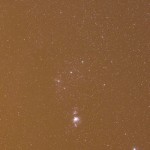Our neighborhood is a somewhat odd case. A large development surrounded by miles of empty land. Get just outside the neighborhood and the skies are quite dark. Inside the neighborhood one has to deal with the usual house lights and a plethora of streetlights. Still, I can see the Milky Way from the driveway, pick out M31 with the unaided eye, and make out a number of star clusters. There is one streetlight directly across the street from my front yard. A notable problem, only partly dealt with by way of a strategically planted Royal Poinciana. A few years old now, the tree has begun to shade the driveway from the worst local light source.
Despite the fact that the neighborhood is disgustingly overlit, there is a mitigating factor. All of the streetlights are low pressure sodium type lights. These lights emit all of their power at 589nm, a sharp emission which can be filtered at the camera. Filters for this and other common light pollution wavelengths are readily available from several manufacturers in a number of sizes and formats.

One minute Orion without LPR filter
While taking some wide field shots using a 50mm lens I had recent opportunity to see the difference with and without the filter. I did not have a filter that fit the 52mm thread on the lens, but rather simply set my 48mm filter on the front of the lens. I had not performed this simple experiment before as the usual mounting location of the filter is buried inside the setup. On this occasion it was a simple matter to take identical frames with and without the filter.
The resulting frames can be seen at the left. These are taken from the camera raw images, imported with daylight color balance, cropped and sized for display. Both images have been handled identically. Neither is a “pretty” picture, these are unprocessed images, none of the stacking, stretching and sharpening that would vastly improve the visual appearance.
The difference is dramatic, without the filter the yellow light from the LPS streetlights floods the frame. At the time the images were taken I was pointing over my garage, the darkest area of my sky, away from the nearest streetlights. Point too close to one of the streetlights and no filter will block the yellow light. The filters do allow me use of much of the sky overhead. While the driveway may be problematic for visual astronomy, I can do astrophotography with the aid of the filters.

A one minute exposure of Orion with the IDAS LPR filter
I use the IDAS LPR filter from Hutech. There are several filters on the market to choose from. But review of the technical specifications and messages traded with some astrophotographer friends convinced me to order the slightly more expensive Hutech filters. This is a decision I have not regretted.
Most of the astrophotos seen on Darker View over the last five years have been through aid of these filters. While I can get away without the filters higher on the mountain I often use them. At the house the filters are indispensable.
The situation might be different if more wide band light sources were located nearby, a condition that afflicts too many of my mainland friends. Even so, the filters do block a number of wavelengths and can improve the resulting images, even from a suburban location. The results may not be as dramatic as mine, but there should be some improvement. There exists an even more extreme solution used by some astrophotographers I know, that of using very narrow-band emission filters. These allow astrophotography from more heavily light polluted locations.

